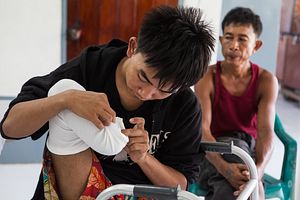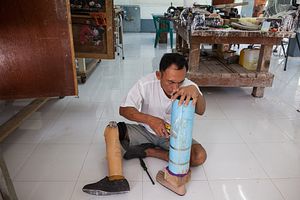Landmines have been commonly used by both sides of what has been described as the world’s longest running civil war between the Myanmar government and Karen ethnic rebels. While the Karen typically plant homemade mines that degrade after a couple of years, the Myanmar military often uses Chinese mines made out of a plastic polymer that takes decades to degrade and cannot be picked up by ordinary metal detectors.
Today, even in areas where the fighting has subsided since the Karen National Union (KNU) signed a ceasefire in 2012, landmines still linger beneath the ground, waiting for victims.
Because Karen State is known to have some of the worst health care in the world, many landmine victims must travel across the Thai-Myanmar border to seek treatment. Within the refugee camps along the border, some facilities – like the Care Villa for the Blind – provide shelter for landmine victims.
Meanwhile, on the Thai side of the border in Mae Sot, places like the Mae Tao Clinic’s Prosthetics Workshop provide treatment completely free of charge. The founder of the clinic, Maw Keh, is a landmine victim himself. A former guerrilla with the KNU, Keh lost his leg during an offensive against Myanmar’s military. Though he moved to Australia in 2014, Keh is proud to have started a workshop that serves patients from both sides of the conflict. “We don’t care who is our enemy, who is our friend, who is civilian,” he says.
The following photos, taken at the Mae Tao Clinic and Care Villa for the Blind, provide a visual look at the human cost of landmines in Myanmar.








































